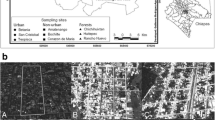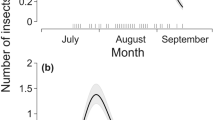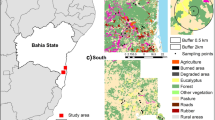Abstract
Temporal variation of insect communities in urban environments is poorly known and mechanisms driving these changes are unclear, as are the implications for insectivorous predators. We examined the relationships between season and nocturnal aerial insect biomass and biodiversity, and between temperature and insect biomass in the Adelaide zoological gardens from December 2005 to September 2006. We also compared the effectiveness of two insect trap types and used a bat detector to assess bat activity in relation to insect biomass. During the study, 9,939 insects from 13 orders were collected at the Adelaide zoo with a Malaise trap and a light trap. Mass and diversity of insects were highest during warm months, as was bat activity, and bat activity was positively correlated with insect biomass. Winter-active insects consisted predominantly of Diptera and Lepidoptera, which may provide an important winter food resource for insectivorous bats. The Malaise trap attracted fewer insect orders and biomass than did the light trap, and insects congregated within 6 m of artificial lights, so bats that forage at lights may have an advantage in urban areas. A strong need for the inclusion of urban insects to biodiversity inventories exists in the context of bat conservation.









Similar content being viewed by others
References
Adams M, Reardon T, Baverstock PR, Watts CH (1988) Electrophoretic resolution of species boundaries in Australian Microchiroptera. IV. The Molossidae. Aust J Biol Sci 41:315–326
Adelaide City Council (2006a) Environmental Management Plan - Local Agenda 21. Available via http://www.adelaidecitycouncil.com/council/publications/ Strategies/Env_Mgt_Plan.pdf. Cited 24 Jul 2006
Adelaide City Council (2006b) Adelaide City Council Map. Available via http://www.adelaidecitycouncil.com/reconciliation/images/map.gif. Cited 10 Jun 2006
Alaruikka D, Kotze DJ, Matveinen K et al (2002) Carabid beetle and spider assemblages along a forested urban-rural gradient in southern Finland. J Insect Conserv 6:195–206
Ali A, Stanley BH, Chaudhuri PK (1986) Attraction of some adult midges (Diptera: Chironomidae) of Florida to artificial light in the field. Fla Entomol 69:644–650
Anthony EL, Stack MH, Kunz TH (1981) Night roosting and the nocturnal time budget of the little brown bat, Myotis lucifugus: effects of reproductive status, prey density, and environmental conditions. Oecologia 51:151–156
Arlettaz R (1996) Feeding behaviour and foraging strategy of free-living mouse-eared bats, Myotis myotis and Myotis blythii. Anim Behav 51:1–11
Arlettaz R, Godat S, Meyer H (2000) Competition for food by expanding pipistrelle bat populations (Pipistrellus pipistrellus) might contribute to the decline of lesser horseshoe bats (Rhinolophus hipposideros). Biol Conserv 93:55–60
Australian Bureau of Statistics (2005) Year book Australia. Available via http://www.abs.gov.au. Cited 22 May 2006
Avery MI (1985) Winter activity by pipistrelle bats. J Anim Ecol 54:721–738
Barclay RM (1991) Population structure of temperate zone insectivorous bats in relation to foraging behaviour and energy demand. J Anim Ecol 60:165–178
Barros F (2001) Ghost crabs as a tool for rapid assessment of human impacts on exposed sandy beaches. Biol Conserv 97:399–404
Bishop AL, McKenzie HJ, Barchia IM et al (2000) Moon phase and other factors affecting light-trap catches of Culicoides brevitarsis Kieffer (Diptera: Ceratopogonidae). Aust J Entomol 39:29–32
Blair RB, Launer AE (1997) Butterfly diversity and human land use: species assemblages along an urban gradient. Biol Conserv 80:113–125
Boyles JG, Dunbar MB, Whitaker JO Jr (2006) Activity following arousal in winter in North American vespertilionid bats. Mammal Rev 36:267–280
Braks MA, Honório NA, Lourenço-De-Oliveira R et al (2003) Convergent habitat segregation of Aedes aegypti and Aedes albopictus (Diptera: Culicidae) in southeastern Brasil and Florida. J Med Entomol 40:785–794
Brown KS, Freitas AV (2002) Butterfly communities of urban forest fragments in Campinas, São Paulo, Brazil: structure, instability, environmental correlates, and conservation. J Insect Conserv 6:217–231
Bureau of Meteorology (2006) Bureau of Meteorology. Available via http://www.bom.gov.au/climate/dwo/IDCJDW0501.shtml. Cited Aug 2006
Campos WG, Pereira DB, Schoereder JH (2000) Comparison of the efficiency of flight-interception trap models for sampling Hymenoptera and other insects. Ecol, Behav Bionomics 29:381–189
Canaday CL (1987) Comparison of insect fauna captured in six different trap types in a Douglas-fir forest. Can Entomol 119:1101–1108
Collier N, Mackay DA, Benkendorff K et al (2006) Butterfly communities in South Australian urban reserves: estimating abundance and diversity using the Pollard walk. Austral Ecol 31:282–220
Corben C (2006) CFCread and AnalookW. Available via www.hoarybat.com
Coulson R, Coulson G (1998) Population change among pacific, kelp and silver gulls using natural and artificial feeding sites in south-eastern Tasmania. Wildl Res 25:183–198
Dadour IR, Cook DF (1992) The effectiveness of four commercial fly traps at catching insects. Aust J Entomol 31:205–208
Daniels CB, Tait CJ (2005) Adelaide: nature of a city: the ecology of a dynamic city from 1836 to 2036. University of Adelaide, Adelaide
De Jong J, Ahlén I (1991) Factors affecting the distribution pattern of bats in Uppland, central Sweden. Holarctic Ecol 14:92–96
Denys C, Schmidt H (1998) Insect communities on experimental mugwort (Artemisia vulgaris L.) plots along an urban gradient. Oecologia 113:269–277
Department for Environment and Heritage (2003) Review of the status of threatened species in South Australia. Government of South Australia, Adelaide
Department for Environment and Heritage (2006) Department for Environment and Heritage. Available via http://www.deh.gov.au/heritage/. Cited 10 Jul 2006
Dover JW, Rowlingson B (2004) The western jewel butterfly (Hypochrysops halyaetus): factors affecting adult butterfly distribution within native Banksia bushland in an urban setting. Biol Conserv 122:599–609
Duchamp JE, Sparks DW, Whitaker JO Jr (2004) Foraging-habitat selection by bats at an urban-rural interface: comparison between a successful and a less successful species. Can J Zool 82:1157–1164
Dunbar MB, Whitaker JO Jr, Robbins LW (2007) Winter feeding by bats in Missouri. Acta Chiropterol 9:305–310
Duncummon SL (2001) Ecological and economic importance of bats: bat conservation and mining, a technical interactive forum. Office of Surface Mining Carbondale, Illinois
Faeth SH, Warren PS, Shochat E et al (2005) Trophic dynamics in urban communities. Bioscience 55:399–407
Fenton MB (1970) A technique for monitoring bat activity with results obtained from a different environment in southern Ontario. J Zool 48:847–851
Garden J, McAlpine C, Peterson A et al (2006) Review of the ecology of Australian urban fauna: a focus on spatially explicit processes. Austral Ecol 31:126–148
Geggie JF, Fenton MB (1985) A comparison of foraging by Eptesicus fuscus (Chiroptera: Vespertilionidae) in urban and rural environments. Can J Zool 63:263–267
Guest P, Jones KE, Tovey J (2002) Bats in greater London: unique evidence of a decline over 15 years. Br Wildl 14:1–5
Hausmann C, Samietz J, Dorn S (2004) Monitoring the dynamics of orchard colonisation by Anthonomus pomorum in spring. Entomol Exp Appl 110:207–216
Hayes JP (1997) Temporal variation in activity of bats and the design of echolocation-monitoring studies. J Mammal 78:514–524
Heinrich B (1987) Thermoregulation by winter-flying endothermic moths. J Exp Biol 127:313–332
Hosking GP (1979) Trap comparison in the capture of flying Coleoptera. NZ Entomol 7:87–92
Hourigan CL, Johnson C, Robson SK (2006) The structure of a micro-bat community in relation to gradients of environmental variation in a tropical urban area. Urban Ecosyst 9:67–82
Hwang C, Turner BD (2005) Spatial and temporal variability of necrophagous Diptera from urban to rural areas. Med Vet Entomol 19:379–391
Intachat J, Woiwod IP (1999) Trap design for monitoring moth biodiversity in tropical rainforests. Bull Entomol Res 89:153–163
Ishitani M, Kotze DJ, Niemelä J (2003) Changes in carabid beetle assemblages across an urban-rural gradient in Japan. Ecography 26:481–489
Kaspari M, Pickering J, Windsor D (2001) The reproductive flight phenology of a neotropical ant assemblage. Ecol Entomol 26:245–257
Kirsten I, Klomp NI (1998) Microchiroptera in urban, rural and forest areas of southern NSW. Australas bat Soc Newsl 2:16–23
Krebs CJ (1999) Ecological methodology. Addison Wesley Longman, California
Kurta A, Teramino JA (1992) Bat community structure in an urban park. Ecography 15:257–261
Lang AB, Kalko EK, Römer H et al (2006) Activity levels of bats and katydids in relation to the lunar cycle. Oecologia 146:659–666
Lee Y, McCracken GF (2005) Dietary variation of Brazilian free-tailed bats links to migratory populations of pest insects. J Mammal 86:67–76
Legakis A, Papadimitriou C, Gaethlich M et al (2000) Survey of the bats of the Athens metropolitan area. Myotis 38:41–46
Lewis T (1959) A comparison of water traps, cylindrical sticky traps and suction traps for sampling Thysanoptera populations at different levels. Entomol Exp Appl 2:204–215
Malaise R (1937) A new insect-trap. Entomol Tidskr 58:148–160
McIntyre NE (2000) Ecology of urban arthropods: a review and a call to action. Ann Entomol Soc Am 93:825–835
McIntyre NE, Rango J, Fagan WF et al (2001) Ground arthropod community structure in a heterogeneous urban environment. Landscape Urban Plann 52:257–274
Mellanby K (1939) Low temperature and insect activity. Philos Trans R Soc Lond, Ser B 127:473–487
Miller JR, Hobbs RJ (2002) Conservation where people live and work. Conserv Biol 16:330–337
Neuweiler G (2000) The biology of bats. Oxford University Press, New York
New TR, Sands DP (2002) Conservation concerns for butterflies in urban areas of Australia. J Insect Conserv 6:207–215
Noyes JS (1989) A study of five methods of sampling Hymenoptera (Insecta) in a tropical rainforest, with special reference to the Parasitica. J Nat Hist 23:285–298
O’Donnell CF (2000) Influence of season, habitat, temperature, and invertebrate availability on nocturnal activity of the New Zealand long-tailed bat (Chalinolobus tuberculatus). NZ J Zool 27:207–221
O’Donnell CF (2002) Timing of breeding, productivity and survival of long-tailed bats Chalinolobus tuberculatus (Chiroptera: Vespertilionidae) in cold-temperate rainforest in New Zealand. J Zool 257:311–323
Parlange M (1998) The city as ecosystem. Bioscience 48:581–585
Pavey CR, Burwell CJ, Grunwald J et al (2001) Dietary benefits of twilight foraging by the insectivorous bat Hipposideros speoris. Biotropica 33:670–681
Piel F, Gilbert M, Franklin§ A et al (2005) Occurrence of Ips typographus (Col. Scolytidae) along an urbanisation gradient in Brussels, Belgium. Agric For Entomol 7:161–167
Racey PA (1982) Ecology of bat reproduction. In: Kunz TH (ed) Ecology of bats. Plenum, New York
Reardon T, Tait CJ (2005) Bats: mammal survivors on the Adelaide plains. In: Daniels CB, Tait CJ (eds) Adelaide: nature of a city: the ecology of a dynamic city from 1836 to 2036. University of Adelaide, Adelaide
Rhodes M, Wardell-Johnson G (2006) Roost tree characteristics determine use by the white-striped freetail bat (Tadarida australis, Chiroptera: Molossidae) in suburban subtropical Brisbane, Australia. Austral Ecol 31:228–239
Rhodes M, Wardell-Johnson G, Rhodes MP (2006) Applying network analysis to the conservation of habitat trees in urban environments: a case study from Brisbane, Australia. Conserv Biol 20:861–870
Rickman JK, Connor EF (2003) The effect of urbanisation on the quality of remnant habitats for leaf-mining Lepidoptera on Quercus agrifolia. Ecography 26:777–787
Rogers LE, Hinds WT, Buschbom RL (1976) General weight vs. length relationships for insects. Ann Entomol Soc Am 69:387–389
Ruffner GA, Poche RM, Meierkord M et al (1979) Winter bat activity over a desert wash in southwestern Utah. Southwest Nat 24:447–453
Russell RC, Webb CE, Williams CR et al (2005) Mark-release-recapture study to measure dispersal of the mosquito Aedes aegypti in Cairns, Queensland, Australia. Med Vet Entomol 19:451–457
Sage RD (1982) Wet and dry-weight estimates of insect and spiders based on length. Am Midl Nat 108:407–411
Sample BE, Cooper RJ, Greer RD et al (1993) Estimation of insect biomass by length and width. Am Midl Nat 129:234–240
Scanlon AT (2006) Factors affecting urban insectivorous bat activity and implications for habitat management in the City of Adelaide, South Australia. Honours Thesis, University of South Australia, Adelaide
Scanlon AT (2007) Difficulties associated with urban bat research. Xanthopus 25:8–10
Speakman JR, Racey PA (1989) Hibernal ecology of the pipistrelle bat: energy expenditure, water requirements and mass loss, implications for survival and the function of winter emergence flights. J Anim Ecol 58:797–813
Strahan R (2002) The Mammals of Australia. Reed Books, London
Svensson BW (1972) Flight periods, ovarian maturation, and mating in Trichoptera at a south Swedish stream. Oikos 23:370–383
Swift SM, Racey PA, Avery MI (1985) Feeding ecology of Pipistrellus pipistrellus (Chiroptera: Vespertilionidae) during pregnancy and lactation. II. Diet. J Anim Ecol 54:217–225
Tait CJ, Daniels CB, Hill RS (2005) Changes in species assemblages within the Adelaide metropolitan area, Australia, 1836–2002. Ecol Appl 15:346–359
Taylor RJ, O’Neill MG (1988) Summer activity patterns of insectivorous bats and their prey in Tasmania. Wildl Res 15:533–539
Turner MS (2001) Conserving Adelaide’s biodiversity: resources. Urban Forest Biodiversity Program, Adelaide
Walker AK, Galbreath RA (1979) Collecting insects at lights: a test of four types of lamp. NZ Entomol 7:83–85
Ward D, Honan P, Lefoe G (2002) Colony structure and nest characteristics of European wasps, Vespula germanica (F.) (Hymenoptera: Vespidae), in Victoria, Australia. Aust J Entomol 41:306–309
Whitaker JO Jr, Rissler LJ (1992) Winter activity of bats at a mine entrance in Vermillion County, Indiana. Am Midl Nat 127:52–59
Wishart E (1999) Adult mosquito (Diptera: Culicidae) and virus survey in metropolitan Melbourne and surrounding areas. Aust J Entomol 38:310–313
Wolda H (1988) Insect seasonality: why? Annu Rev Ecol Syst 19:1–18
Zapparoli M (1997) Urban development and insect biodiversity of the Rome area, Italy. Landscape Urban Plann 38:77–86
Acknowledgements
We thank Robert Aebi, Peter Baldacchino, Bruno Castellucci, Roger Clay, Alan Dickens, Zoe Drechsler, Alice Egan, Mike Gemmell, Joan Gibbs, Chris Havelberg, David Hunt, Rodney Hutchinson, Greg Johnston, Serina Lattanzio, Martin Lewicki, Chris Pavey, Angi Pestell, Terry Reardon, Philip Roetman, Janine Slocombe, Fleur Tiver, and Ashley walker for their technical and field support. We acknowledge Nancy McIntyre as well as anonymous reviewers for reading the manuscript. We thank the Adelaide City Council, the SA Museum for assistance with insect identification, the Royal Zoological Gardens of South Australia for facilitating access to the study site, as well as the Australian Bureau of Meteorology for temperature data; this study was funded by the Field Naturalists’ Society of South Australia’s Lirabenda Fund, the Nature Conservation Society of South Australia’s Conservation Biology Grant, and the University of South Australia’s Summer Scholarship program. This research was part of A. Scanlon’s Honours thesis and received funding from the School of Natural and Built Environments Honours program in Biodiversity, Environmental and Park Management. The IMVS animal users permit no. was 057/05 and the Department for Environment and Heritage permit no. was M 25074 1.
Author information
Authors and Affiliations
Corresponding author
Rights and permissions
About this article
Cite this article
Scanlon, A.T., Petit, S. Biomass and biodiversity of nocturnal aerial insects in an Adelaide City park and implications for bats (Microchiroptera). Urban Ecosyst 11, 91–106 (2008). https://doi.org/10.1007/s11252-007-0043-6
Received:
Accepted:
Published:
Issue Date:
DOI: https://doi.org/10.1007/s11252-007-0043-6




